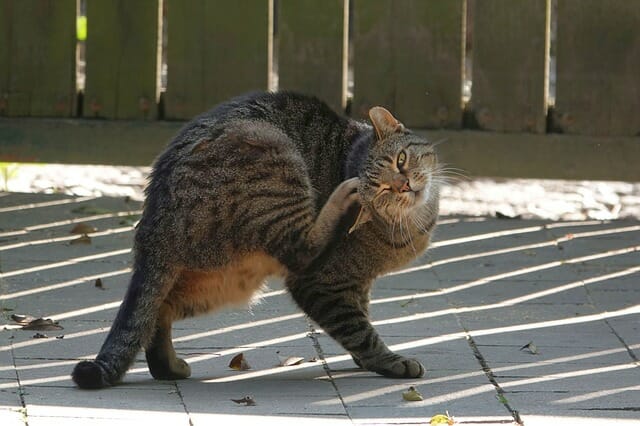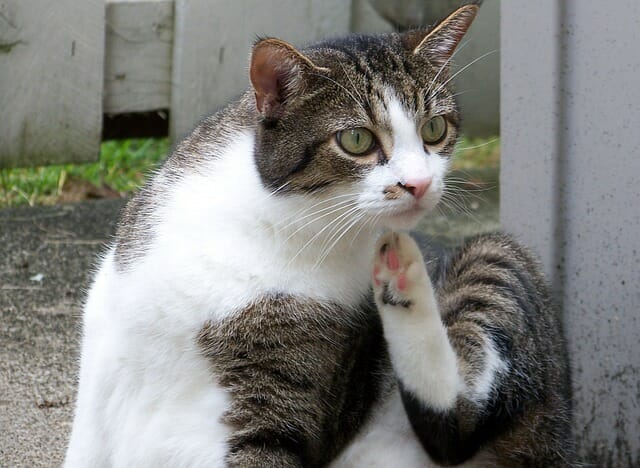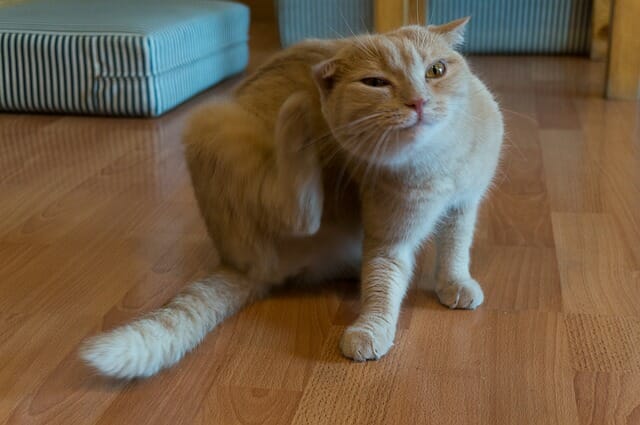Why Does My Cat Have Dandruff: Reasons Why Cats Have Dandruff and How to Deal With It
Dry skin is one of the common reasons why cats may have dandruff. Various factors, including environmental conditions such as low humidity, poor diet, and inadequate grooming, can cause dry skin.


Here are some tips for treating dry skin in cats:
- Use a humidifier: Getting a humidifier for your cat’s environment can help increase the humidity and prevent dry skin.
- Improve your cat’s diet: Feeding your cat a balanced diet with the proper amount of essential fatty acids can help improve their skin and coat health.
- Groom your cat regularly: Regular grooming, such as brushing and bathing, can help remove dead skin cells and distribute natural oils throughout your cat’s coat.
- Use a moisturizing shampoo: A moisturizing shampoo specifically designed for cats can help soothe dry skin and improve their coat health.
- Provide supplements: Omega-3 and Omega-6 can help improve skin and coat health, especially if your cat’s diet lacks these essential fatty acids.
Table of Contents
Reasons Why Cats Have Dandruff
Allergies
Allergies are another common cause of dandruff in cats, according to VMBS News. Cats can get allergies to various environmental factors, including pollen, dust, mold, and certain foods. Allergies can cause dry, itchy skin and may lead to excessive scratching and grooming, resulting in dandruff.
If you suspect your cat has allergies, it’s important to consult with your veterinarian to identify the underlying factors and develop an appropriate treatment plan. Identifying and avoiding the allergen causing your cat’s symptoms can help manage their allergies. This may involve changing their environment, such as using air purifiers, keeping cats away from certain plants, or changing their diet to eliminate potential allergens.
Your veterinarian may recommend medications, such as antihistamines or corticosteroids, to help manage your cat’s allergy symptoms. Omega-3 and Omega-6 supplements can help improve skin and coat health and reduce the severity of allergy symptoms.
Parasites
Parasites are another potential cause of dandruff in cats. For example, fleas, ticks, and other parasites can irritate your cat’s skin and cause them to scratch and groom excessively, leading to dandruff. Using flea and tick prevention products can help protect your cat from these parasites and reduce their risk of developing dandruff.
Regular grooming can help remove fleas and ticks from your cat’s coat and reduce the amount of dandruff they produce. In addition, your veterinarian may recommend medications, such as flea and tick repellents or topical ointments, to help manage your cat’s parasite infestation.
Keeping your home clean and clutter-free is important to reduce the risk of parasites in your cat’s environment. Vacuuming regularly and washing your cat’s bedding and toys can help eliminate fleas and ticks from your home.
Underlying Health Conditions
Underlying health conditions can also cause dandruff in cats. Here are some of the common health conditions that can cause dandruff in cats:


- Hypothyroidism: Hypothyroidism is when the thyroid gland does not produce enough thyroid hormone. This can cause dry skin, dandruff in cats, and other symptoms such as lethargy, weight gain, and hair loss.
- Diabetes: Diabetes can cause dry skin and dandruff in cats, as well as other symptoms such as increased thirst, urination, and weight loss.
- Nutritional deficiencies: A lack of essential fatty acids, vitamins, or minerals in your cat’s diet can also cause dry skin and dandruff.
- Allergies: Cats can be allergic to various substances, including food, pollen, and flea bites. Allergies can cause dry skin, itching, and dandruff.
- Skin infections: Skin infections caused by bacteria, fungi, or parasites can cause dry skin and cat dandruff.
Tips to Get Rid of Cat Dandruff
Regular Grooming
Regular grooming is important to maintaining your cat’s skin and coat health, which can help reduce dandruff. Use a soft-bristled brush or comb to remove dead skin cells, distribute natural oils, and detangle your cat’s coat. Brush or comb your cat toward hair growth, and be gentle to avoid causing skin irritation.
Pay attention to areas where your cat is more prone to dandruff, such as the base of the tail, back, and flanks. Groom these areas more frequently to help reduce dandruff buildup. For example, consider using grooming products, such as wipes or sprays, specifically designed to help reduce cat dandruff. These products can help remove dead skin cells and soothe dry, itchy skin.
Consistent grooming can help prevent dandruff buildup and promote healthy skin and coat. Make grooming a regular part of your cat’s routine, and groom them at least once a week.
Use a Humidifier
Using a humidifier can help add moisture to the air, which can help soothe dry skin and reduce dandruff in cats. Choose an appropriately sized humidifier for the room where your cat spends the most time. For example, a small humidifier may be sufficient for a bedroom or small living area, while a larger humidifier may be necessary for a larger space.
Follow the manufacturer’s instructions for setting up and using the humidifier. This may include filling the water tank, adjusting the humidity level, and cleaning the humidifier regularly. Place the humidifier in the room where your cat spends the most time, such as the living room or bedroom. Avoid placing the humidifier too close to your cat’s bed or litter box, as this can create too much humidity in those areas.
Use a hygrometer to monitor the humidity levels in your home. Aim for a humidity level between 40 and 60 percent, as too much humidity can promote mold and bacteria growth. Clean the humidifier regularly to prevent the buildup of mold and bacteria. Follow the manufacturer’s instructions for cleaning the humidifier, and be sure to change the water and clean the humidifier at least once a week.
Provide a High-Quality Diet
Providing your cat with a high-quality diet is essential for maintaining healthy skin and coat. For example, choose a cat food that contains high-quality protein sources, such as chicken, fish, or turkey. These protein sources provide cats with essential amino acids for healthy skin and coats.


Avoid cat foods that contain fillers, such as corn or wheat, as these ingredients provide little nutritional value for your cat. Also, avoid cat foods that contain by-products, such as chicken by-products, as these ingredients are often lower quality and less digestible than whole meat sources.
Add supplements, such as omega-3 fatty acids, to your cat’s diet. These supplements can help reduce inflammation and improve skin and coat health. Ensure your cat has access to fresh, clean water at all times. Dehydration can cause dry, itchy skin and contribute to dandruff.
Use a Moisturizing Shampoo
Look for a cat shampoo containing natural, moisturizing ingredients such as aloe vera, oatmeal, or coconut oil. Follow the instructions on the shampoo bottle. Some shampoos require dilution before use, while others are ready to use straight out of the bottle.
When shampooing your cat, be gentle and avoid scrubbing too hard. Use warm water to wet your cat’s coat, then apply a small amount of shampoo and massage it into your cat’s skin and coat. Ensure to avoid getting shampoo in your cat’s eyes or ears. Rinse your cat thoroughly with warm water to remove all of the shampoos. Rinse the shampoo off completely, as any residue can cause skin irritation.
Use a clean towel to dry your cat thoroughly after shampooing. If your cat is comfortable with it, you can also use a blow dryer set to a low heat setting to dry your cat’s coat.
